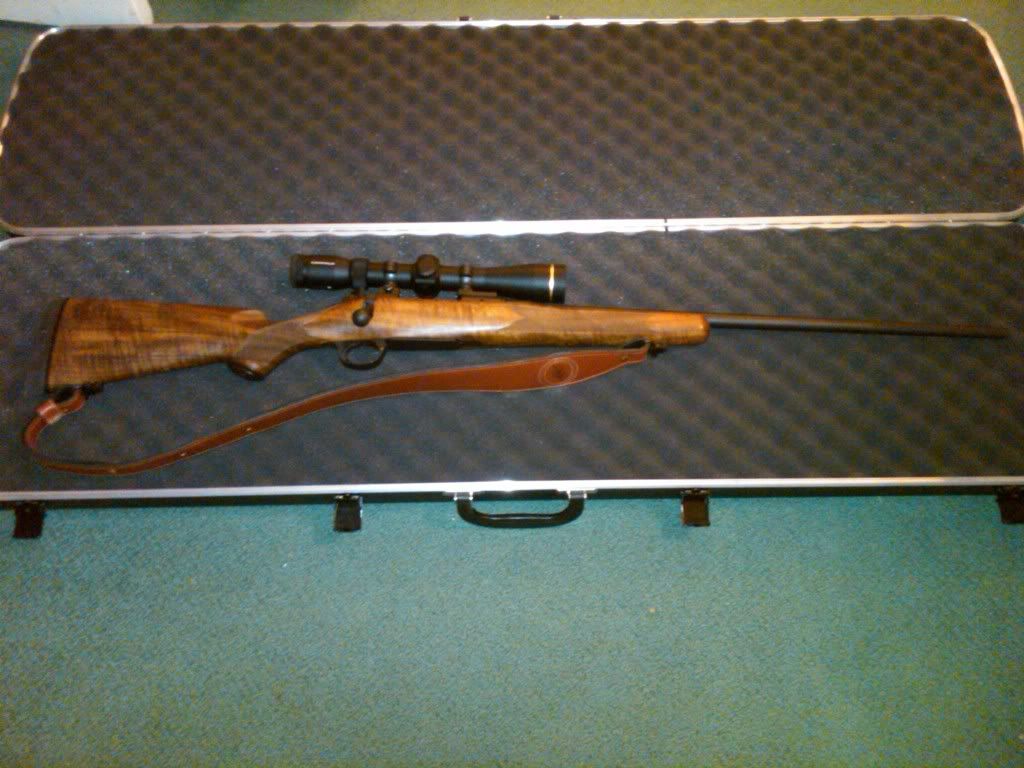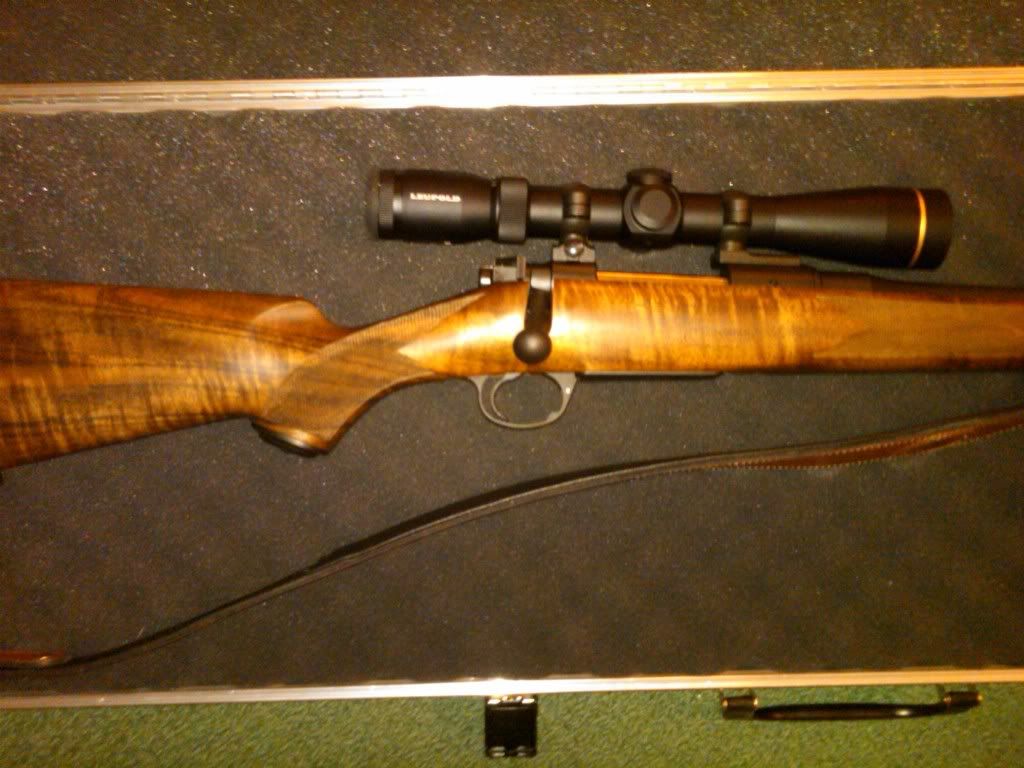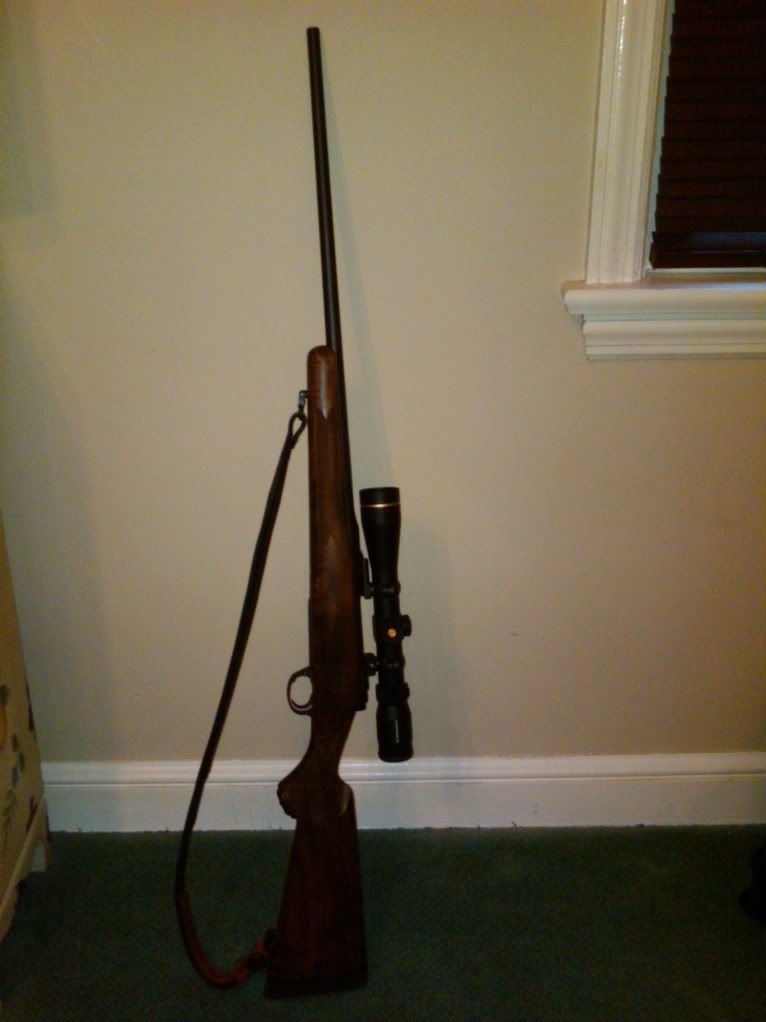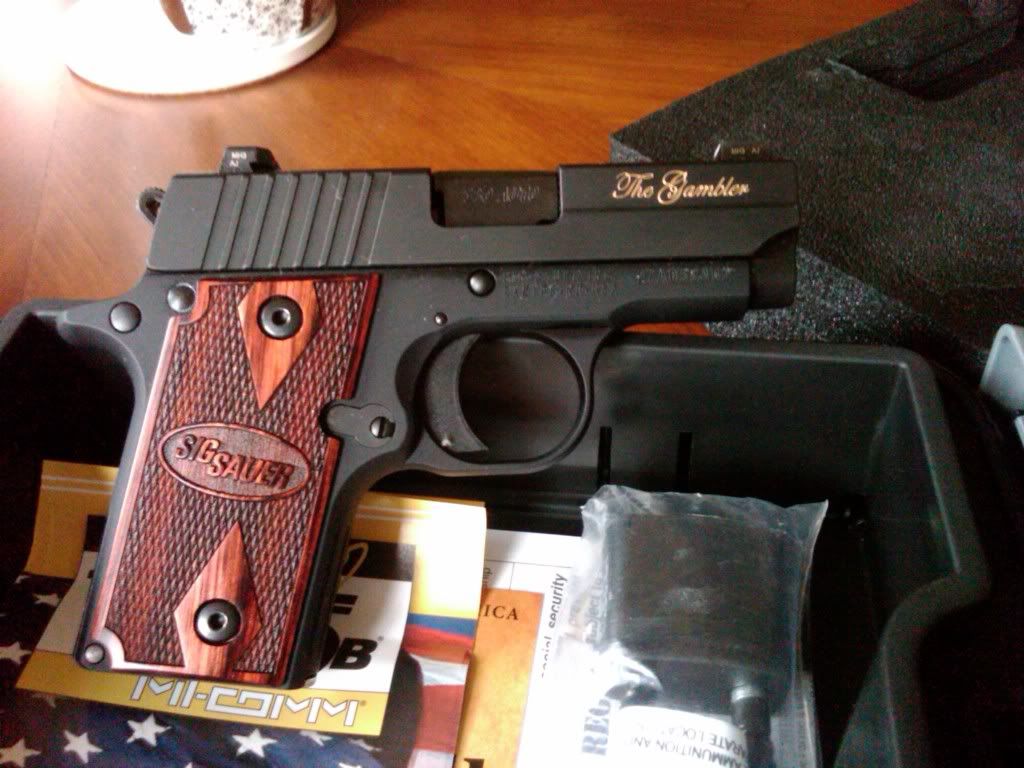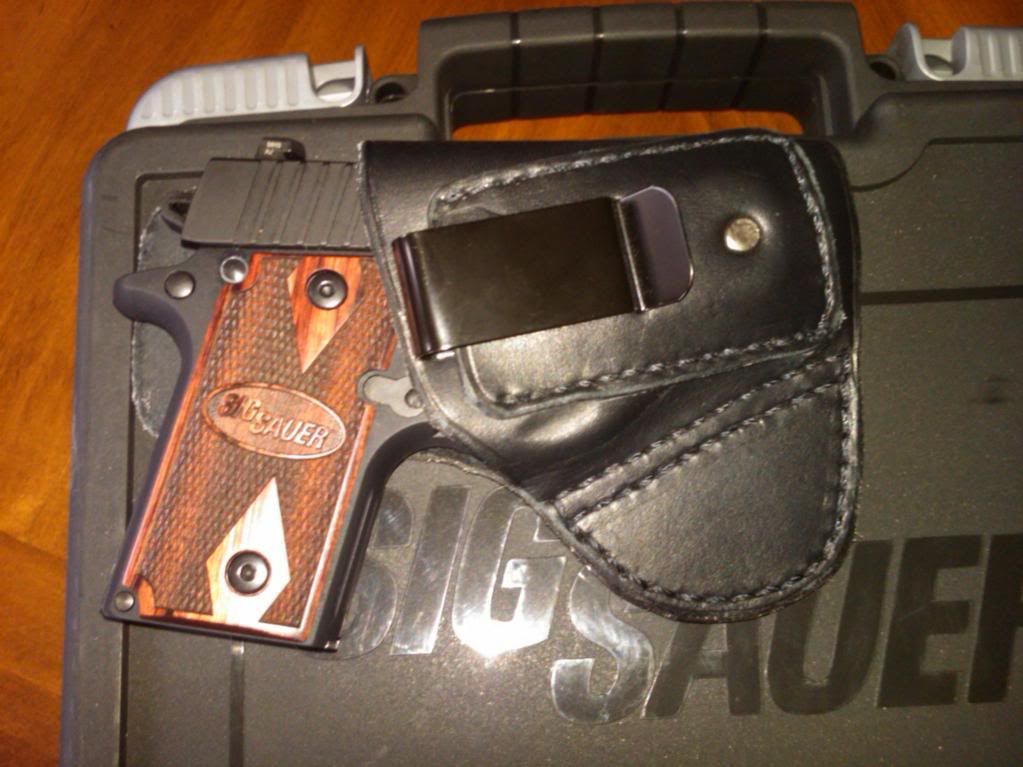I've had my eye on two tactical rifles for the past several months: the Sig 556 Classic and the S&W M&P-15 (AR-15). After reading several bad reviews of the Sig, I was pretty much ready to pull the trigger on the M&P-15 when I suddenly decided to join a hunting lease in Arkansas. That changed everything ....
With that, I needed a rifle that was fit for hunting whitetail deer. After kicking it around for several days, I finally decided to go with a Kimber 8400 in .270 Winchester Short Magnum. I already know Kimber makes damn fine pistols, and this rifle certainly appears to be typical Kimber quality fit and finish. I opted for the .270 WSM because it was a terrific balance of power and velocity. A 150 grain Winchester Supreme Elite round drops less than 34 inches at 500 yards. That's about 2/3 of the drop of a 30-06 at that distance.
I added Leupold VX-R optics at 3-9x40mm. It has a "Firedot" reticle that actually lights up on the target. Interested to see how that works. It took nearly a month for the jackasses at the gun shop to mount the damn thing, but I guess it's better late than never.
In any event, I am shooting it for the first time this weekend, so we'll see how it fires. In the meantime, a few pictures:
Thursday, May 19, 2011
Friday, May 13, 2011
Since we're talking about pistols ...
or at least, since I'M talking about pistols (zero comments to date on this blog), I may as well move on to the next one in my collection. I chose the next pistol because I learned that when it comes to carrying one around, (not unlike fashion accessories) there are times when certain guns are better for certain situations or attire. For example, while I love my Kimber CDP and its thunderous, threat-eradicating .45 caliber power, it's not always easy to carry if you're wearing shorts and a T-shirt. For those times, I chose the Sig Sauer P238 in .380 ACP shown here:
It's ultra-compact (it literally fits in the palm of my hand) so it's ideal for any situation where carrying something more bulky isn't practical. In fact, most people who carry this and other guns this size simply carry them in the front pocket. I prefer the tiny inside-the-waistband holster option shown here:
As far as how this little firearm performs, my impressions on the key aspects are set forth below. In sum, I had high expectations for the SIG, and they were mostly met or exceeded.
Trigger Feel. The trigger has a short, crisp pull. It's in no way on par with my Kimber 1911 (nor would I expect it to be), but for a gun this size, it's VERY nice. I think it might be a teeny tad heavy for my liking, but not so heavy it affects accuracy much.
Sights. Bright and easy to find on follow ups. Nicely done SIG. If ever I need it, they glow like crazy in the dark.
Fit in the hand. Well, it's a small framed auto, so it's going to feel a little awkward on the pinkie to some. Just picking it up, it doesn't feel as comfortable as say the Bodyguard on the pinkie. However, it does feel great near the thumb, especially while shooting.
Shooting Feel. Here's where this little gun starts to stand out. The recoil is incredibly light and smooth. I know what you're thinking -- it's a friggin' .380, OF COURSE the recoil is light and smooth. True -- no .380 is going to vigorously roll back the hand of any half-grown man (or most women and children for that matter), but compared to peer offerings such as the S&W Bodyguard and the Beretta Tomcat (I've shot both in recent weeks), it's a dream to shoot. The contrast between the SIG and those guns is striking. I was sort of surprised by the discomfort I experienced shooting the Bodyguard, and downright angry with the Tomcat after about 100 rounds. [NOTE: Regarding the Tomcat, emptying a mag from that little .32 ACP beast was like having someone hit me 7 times with a ball peen hammer between the thumb and index finger -- I couldn't WAIT to stop shooting it.] The SIG on the other hand, felt like pushing tacks or staples into soft corkboard. Hard to describe -- it was just very smooth and controlled, and comfortable.
Accuracy. In a word, surprising for a gun this size and caliber. I easily hit center mass at 15 yards, and shot groups at 7 yards that I would have a hard time duplicating with my full size M&P (4.25" bbl).
Other considerations. I did experience 3 failure to feed's in the 100 round outing. Obviously his failure rate is unacceptable for a CCW application. However, I learned with my Kimber that this can happen during the break in period and completely disappear after a few hundred rounds. The last 150 rounds have been flawless, so I'm hopeful she's broken in to the point where future failures won't occur. Also, SIG sort of ticked me off with the decision to include only a single magazine. This gun is one of the most expensive in its class, and Sig can't throw in a single extra magazine? Come on guys, really? More importantly, however, fully securing the mag into the mag well (to avoid having nothing happen when you pull the trigger) is not as easy as it should be. It's hard enough to secure a flush .45 mag (which is why I like the tac mag extensions on my Kimber) but on the tiny .380, it's a whole other level of not-easy. SIG has figured out a fix for two of my complaints with their new extra round, pinkie extended magazine. However, I can't seem to find one in stock anywhere on the planet. Moreover, I think at least one of them (together with another flush mag) should be included with every P238.
All things considered, I'm very pleased so far.
Rating: **** (of *****). You're probably figuring out by now that you won't find too many guns which are still in my collection that are rated less than ****. If I don't really like it, it goes bye bye.
It's ultra-compact (it literally fits in the palm of my hand) so it's ideal for any situation where carrying something more bulky isn't practical. In fact, most people who carry this and other guns this size simply carry them in the front pocket. I prefer the tiny inside-the-waistband holster option shown here:
As far as how this little firearm performs, my impressions on the key aspects are set forth below. In sum, I had high expectations for the SIG, and they were mostly met or exceeded.
Trigger Feel. The trigger has a short, crisp pull. It's in no way on par with my Kimber 1911 (nor would I expect it to be), but for a gun this size, it's VERY nice. I think it might be a teeny tad heavy for my liking, but not so heavy it affects accuracy much.
Sights. Bright and easy to find on follow ups. Nicely done SIG. If ever I need it, they glow like crazy in the dark.
Fit in the hand. Well, it's a small framed auto, so it's going to feel a little awkward on the pinkie to some. Just picking it up, it doesn't feel as comfortable as say the Bodyguard on the pinkie. However, it does feel great near the thumb, especially while shooting.
Shooting Feel. Here's where this little gun starts to stand out. The recoil is incredibly light and smooth. I know what you're thinking -- it's a friggin' .380, OF COURSE the recoil is light and smooth. True -- no .380 is going to vigorously roll back the hand of any half-grown man (or most women and children for that matter), but compared to peer offerings such as the S&W Bodyguard and the Beretta Tomcat (I've shot both in recent weeks), it's a dream to shoot. The contrast between the SIG and those guns is striking. I was sort of surprised by the discomfort I experienced shooting the Bodyguard, and downright angry with the Tomcat after about 100 rounds. [NOTE: Regarding the Tomcat, emptying a mag from that little .32 ACP beast was like having someone hit me 7 times with a ball peen hammer between the thumb and index finger -- I couldn't WAIT to stop shooting it.] The SIG on the other hand, felt like pushing tacks or staples into soft corkboard. Hard to describe -- it was just very smooth and controlled, and comfortable.
Accuracy. In a word, surprising for a gun this size and caliber. I easily hit center mass at 15 yards, and shot groups at 7 yards that I would have a hard time duplicating with my full size M&P (4.25" bbl).
Other considerations. I did experience 3 failure to feed's in the 100 round outing. Obviously his failure rate is unacceptable for a CCW application. However, I learned with my Kimber that this can happen during the break in period and completely disappear after a few hundred rounds. The last 150 rounds have been flawless, so I'm hopeful she's broken in to the point where future failures won't occur. Also, SIG sort of ticked me off with the decision to include only a single magazine. This gun is one of the most expensive in its class, and Sig can't throw in a single extra magazine? Come on guys, really? More importantly, however, fully securing the mag into the mag well (to avoid having nothing happen when you pull the trigger) is not as easy as it should be. It's hard enough to secure a flush .45 mag (which is why I like the tac mag extensions on my Kimber) but on the tiny .380, it's a whole other level of not-easy. SIG has figured out a fix for two of my complaints with their new extra round, pinkie extended magazine. However, I can't seem to find one in stock anywhere on the planet. Moreover, I think at least one of them (together with another flush mag) should be included with every P238.
All things considered, I'm very pleased so far.
Rating: **** (of *****). You're probably figuring out by now that you won't find too many guns which are still in my collection that are rated less than ****. If I don't really like it, it goes bye bye.
Monday, May 9, 2011
It's sort of like playing cops and robbers, but with LIVE ammo ...
That's the description I recently provided a co-worker when he asked me what exactly I meant when I said I went "IDPA" shooting over the weekend. More technically, IDPA (which stands for "International Defensive Pistol Association") is an association formed to allow its members to practice shooting skills in simulated self-defense scenarios. Shooters are classified as either novice, marksman, sharpshooter, expert or master for a given weapon (standard or enhanced service pistols, custom defense pistols or revolvers). By far, the easiest way to describe IDPA is to refer you directly to one of the many you tube videos on the subject, like this one:
So anyway, I shot my first IDPA event a few days ago. It was a lot like the one depicted in the previously posted video. I shot from behind barrels, from behind desks and through car windows. I shot at still targets, disappearing targets, and swinging targets. I shot with my left hand. In a word, it was AWESOME. It's SO much cooler than just shooting pieces of paper at my normal indoor range.
As for how well I shot? Well, I finished 32nd out of 38 semi-auto shooters. (Results can be seen here: New Holland IDPA Scores (May 1, 2011)). Among the beginners and novice level shooters, I was roughly in the middle of the pack, which exceeded my well-published pre-shoot goal of "don't be last!" In all, I was pretty happy. I committed three errors that I consider major: (1) failing to shoot two bad guys (FN, or "failure to neutralize" for those keeping score); (2) dropping a mag to the dirt while doing a tactical (non-empty gun) reload rather than stowing it on my person; and (3) "sweeping" the muzzle of the gun over my left arm while climbing out of the car to shoot more bad guys -- a genuine NO NO (for obvious reasons). I didn't even realize I did the last error until I saw the replay on a video that another competitor had recorded. (NOTE: Speaking of which, if the aforementioned other shooter emails me the vids of me event, I'll post. Unless they make me look like a dumbass, in which case I'll delete them.)
My M&P performed well, though it's a lot tougher to acquire and shoot multiple targets in an IDPA situation than I had anticipated. The two main components of score are speed and accuracy. I can tell you, I wasn't particularly fast, nor should I have been. In fact, if anything I was probably trying to be a little too fast for a beginner. As a result, I wasn't particularly accurate either, scoring 65 "points down" which was a relatively high figure. Points down are added to your time for not making center hits (which can range from just-off of the 10" center target to my perviously-mentioned FNs).
Nevertheless, despite the errors and the less-than-spectactular score, I had a great time, and plan to shoot these events regularly. The next match at New Holland is a "classifier," which means my score will translate into a classification, which I will then wear like a scarlet letter until I shoot another classifier that translates into a new classfication. I hope to shoot better in that one.
So anyway, I shot my first IDPA event a few days ago. It was a lot like the one depicted in the previously posted video. I shot from behind barrels, from behind desks and through car windows. I shot at still targets, disappearing targets, and swinging targets. I shot with my left hand. In a word, it was AWESOME. It's SO much cooler than just shooting pieces of paper at my normal indoor range.
As for how well I shot? Well, I finished 32nd out of 38 semi-auto shooters. (Results can be seen here: New Holland IDPA Scores (May 1, 2011)). Among the beginners and novice level shooters, I was roughly in the middle of the pack, which exceeded my well-published pre-shoot goal of "don't be last!" In all, I was pretty happy. I committed three errors that I consider major: (1) failing to shoot two bad guys (FN, or "failure to neutralize" for those keeping score); (2) dropping a mag to the dirt while doing a tactical (non-empty gun) reload rather than stowing it on my person; and (3) "sweeping" the muzzle of the gun over my left arm while climbing out of the car to shoot more bad guys -- a genuine NO NO (for obvious reasons). I didn't even realize I did the last error until I saw the replay on a video that another competitor had recorded. (NOTE: Speaking of which, if the aforementioned other shooter emails me the vids of me event, I'll post. Unless they make me look like a dumbass, in which case I'll delete them.)
My M&P performed well, though it's a lot tougher to acquire and shoot multiple targets in an IDPA situation than I had anticipated. The two main components of score are speed and accuracy. I can tell you, I wasn't particularly fast, nor should I have been. In fact, if anything I was probably trying to be a little too fast for a beginner. As a result, I wasn't particularly accurate either, scoring 65 "points down" which was a relatively high figure. Points down are added to your time for not making center hits (which can range from just-off of the 10" center target to my perviously-mentioned FNs).
Nevertheless, despite the errors and the less-than-spectactular score, I had a great time, and plan to shoot these events regularly. The next match at New Holland is a "classifier," which means my score will translate into a classification, which I will then wear like a scarlet letter until I shoot another classifier that translates into a new classfication. I hope to shoot better in that one.
Thursday, May 5, 2011
Beauty + Function = Kimber ...
If you find yourself in the market for a hand cannon (e.g., a .45 ACP) and can manage to scrape together a few extra coins, you should definitely check out a Kimber. Based upon the century old 1911 auto platform invented by John Browning, Kimber pistols are truly works of art. I opted for the ultra miniaturized Ultra Custom Defense Pistol II, which combines a very concealable 3" barrel platform with several Kimber custom shop features, such hand checkered grips, night sights and ambidextrous safety.
This tiny little aluminum-framed beast weighs in at 24 ounces unloaded, making it one of the lightest (if not the lightest) .45 ACP 1911 frames on the planet. That comes in handy when you want to carry something with real kick that won't pull your pants down. [NOTE: More to come later on concealed carry and permits.]
Speaking of real kick, any of you that shoot know that recoil is typically a function of three things -- bullet weight, powder load, and gun weight. I'm not a math guy, so I'm not sure what equation to use to explain this phenomenon. Instead, I will simply tell you this -- when you pull the trigger on this high caliber, light-ass gun that barely fills your hand, you won't have to wait for your ears to ring to know that you've sent lead downrange.
What sets this gun apart from the others in my collection, however, goes beyond beauty and concealibility. This little SOB will flat out shoot. A couple of weeks ago, I put 28 rounds (4 mags) into the hi visibility portions of these targets from 30 or so feet (ignore the other holes in the Target that Kristen sprayed all over the place. :-) ).
1911's are known for their remarkable accuracy, but most of them are in 5" or 4" barrels. 3" barrels typically are not known as accurate shooting platforms because (1) longer barrels generally equate to greater accuracy, and (2) the distance between the front and rear sights on shorter barrelled firearms makes it harder to shoot accurately. All of that said, a week after this picture was taken, I placed 4 of 7 rounds on 1" round dot targets from 30 feet. In sum, this gun's accuracy doesn't seem to be limited much by it's barrel length. Human-sized targets should easily be struck from distances out to 25 meters. In fact, my Kimber's only limitation seems to be me. But hey, I'm getting better!
One more thing on 1911's. There probably isn't a more beloved pistol platform in the world. These pistols have served as the primary sidearm through almost every U.S. military conflict since the Civil War. Only relatively recently have they begun to be replaced by service pistol platforms (such as my M&P 9mm or Glocks) for military and law enforcement use. Still, they have a remarkable civilian following. These platforms are the primary choice of nearly all serious competition action pistol shooters. Out of the box, the action, trigger feel and accuracy are hard to beat. 1911's are hand and custom built by any number of talented gun artisans, and can range in price from $450 (Taurus) to over $10,000 (Volkmann Custom). I am told by some of acquaintences who share my hobby of gun collecting and shooting that every person should own at least 3 1911's. [Please don't tell my wife that, though -- she'll only shake her head and mutter "good grief."]
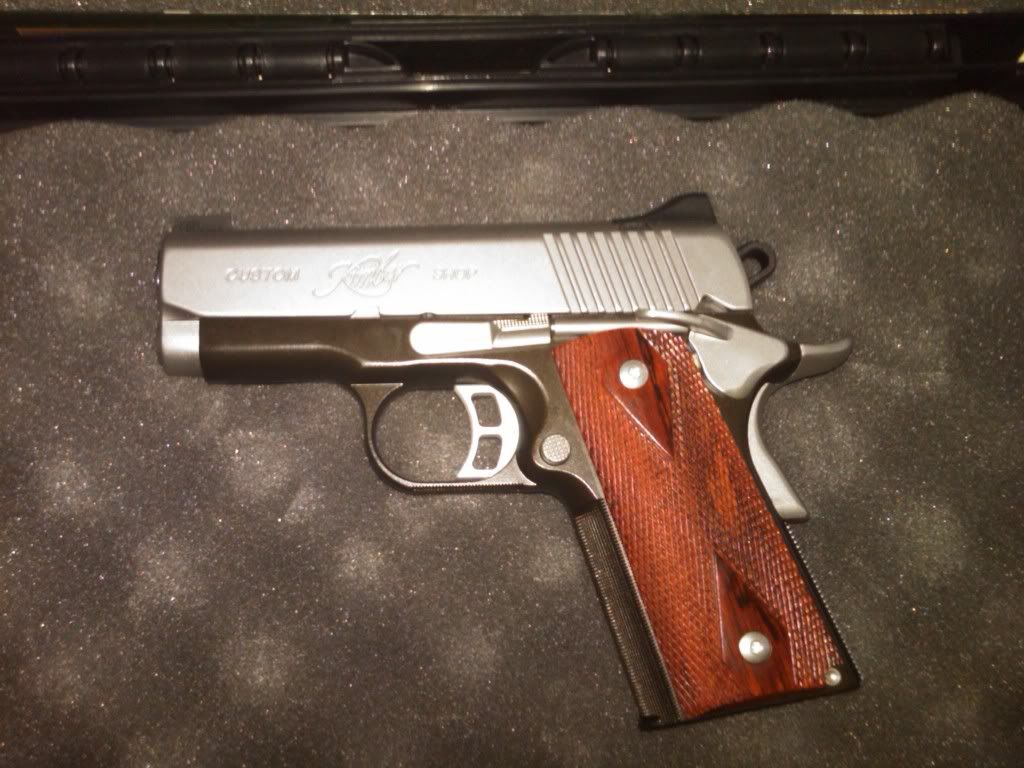 |
| Kimber Ultra CDP II (.45 ACP) |
Speaking of real kick, any of you that shoot know that recoil is typically a function of three things -- bullet weight, powder load, and gun weight. I'm not a math guy, so I'm not sure what equation to use to explain this phenomenon. Instead, I will simply tell you this -- when you pull the trigger on this high caliber, light-ass gun that barely fills your hand, you won't have to wait for your ears to ring to know that you've sent lead downrange.
What sets this gun apart from the others in my collection, however, goes beyond beauty and concealibility. This little SOB will flat out shoot. A couple of weeks ago, I put 28 rounds (4 mags) into the hi visibility portions of these targets from 30 or so feet (ignore the other holes in the Target that Kristen sprayed all over the place. :-) ).
 |
| 10 Meters, No rest, approximately 1 minute |
One more thing on 1911's. There probably isn't a more beloved pistol platform in the world. These pistols have served as the primary sidearm through almost every U.S. military conflict since the Civil War. Only relatively recently have they begun to be replaced by service pistol platforms (such as my M&P 9mm or Glocks) for military and law enforcement use. Still, they have a remarkable civilian following. These platforms are the primary choice of nearly all serious competition action pistol shooters. Out of the box, the action, trigger feel and accuracy are hard to beat. 1911's are hand and custom built by any number of talented gun artisans, and can range in price from $450 (Taurus) to over $10,000 (Volkmann Custom). I am told by some of acquaintences who share my hobby of gun collecting and shooting that every person should own at least 3 1911's. [Please don't tell my wife that, though -- she'll only shake her head and mutter "good grief."]
Tuesday, May 3, 2011
Why I love my M&P 9mm ...
1. It's ergonomically perfect. This firearm might not be the prettiest on the planet, but I can't tell you how many times I've heard others who own it claim it just "feels" right in the hand. It's balanced and has a natural on-target cant when loaded. Feeling comfortable in the hand is an important component of a good pistol. Here's a basic photo from a poor angle, but you get the point:
2. It's Accurate. Right out of the box, an average shooter will have very little trouble putting rounds on target (or at least, close enough to count).
3. It's Incredibly Reliable. I'm nearing the 2,000 round mark without experiencing a single failure of any kind with all types and brands of ammo. That's a Glock-like and nearly unheard of reliability rate in a semi-auto.
4. It's Easily Upgradeable. Without getting too technical, for about $90 and 90 minutes of your time (or 20 minutes of time from a quality gunsmith), you can replace several trigger components (sear, springs, etc...) which will improve the trigger pull significantly (increasing accuracy). There are also a number of gunsmiths who perform upgrades on these guns on the cheap. It also has standard rails for a light or other add ons.
5. It's Great for Action Pistol Shooting. There are few reasonably priced pistols that are as suitable right out of the box for IDPA competition. If you are so inclined, you can spend a few extra dollars for a trigger kit and perhaps some new sights (like I did), and be WELL equipped in the Standard Service Pistol category. This past weekend, of the 15 or so shooters in my beginner's squad, I counted 5 M&Ps and no more than 2 of any other variety. (Note: I'll have more on IDPA later.)
OVERALL RATING: **** (of *****). This pistol fits many categories very well. For a full size 9mm, it has few peers in its price range. Most pistols in that price range are going to be *** or below, but the upgradeability and superior reliability make this weapon a cut above the others in the marketplace.
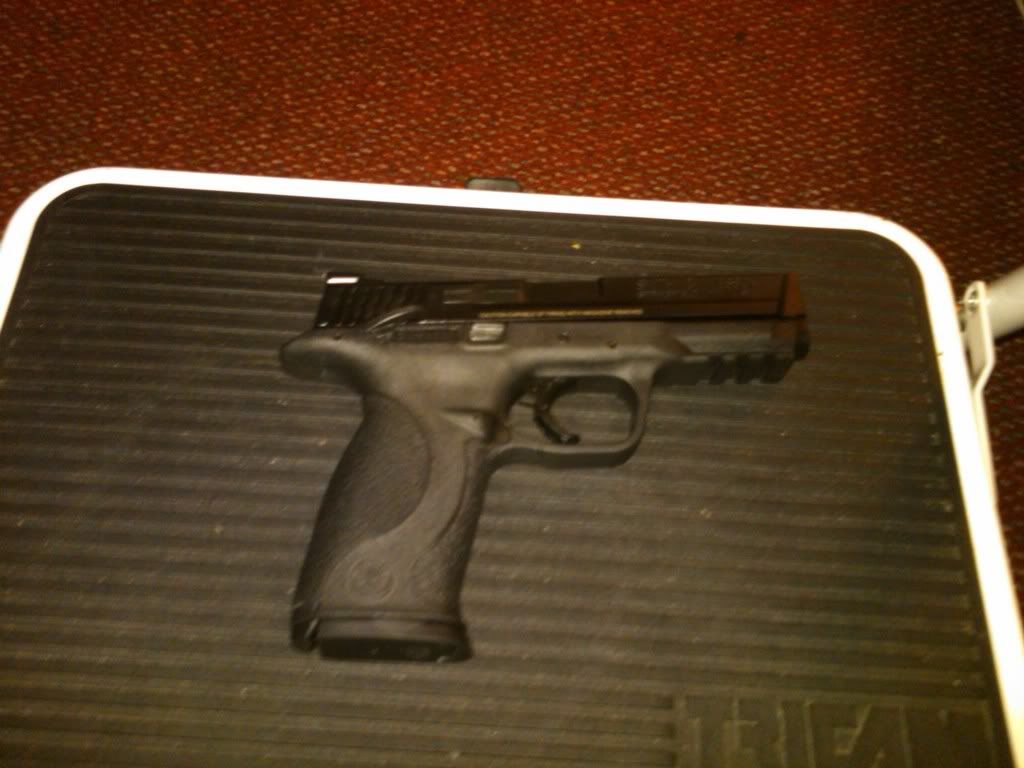 |
| Smith & Wesson M&P 9mm (full-size, 17 rounds) |
3. It's Incredibly Reliable. I'm nearing the 2,000 round mark without experiencing a single failure of any kind with all types and brands of ammo. That's a Glock-like and nearly unheard of reliability rate in a semi-auto.
4. It's Easily Upgradeable. Without getting too technical, for about $90 and 90 minutes of your time (or 20 minutes of time from a quality gunsmith), you can replace several trigger components (sear, springs, etc...) which will improve the trigger pull significantly (increasing accuracy). There are also a number of gunsmiths who perform upgrades on these guns on the cheap. It also has standard rails for a light or other add ons.
5. It's Great for Action Pistol Shooting. There are few reasonably priced pistols that are as suitable right out of the box for IDPA competition. If you are so inclined, you can spend a few extra dollars for a trigger kit and perhaps some new sights (like I did), and be WELL equipped in the Standard Service Pistol category. This past weekend, of the 15 or so shooters in my beginner's squad, I counted 5 M&Ps and no more than 2 of any other variety. (Note: I'll have more on IDPA later.)
OVERALL RATING: **** (of *****). This pistol fits many categories very well. For a full size 9mm, it has few peers in its price range. Most pistols in that price range are going to be *** or below, but the upgradeability and superior reliability make this weapon a cut above the others in the marketplace.
Monday, May 2, 2011
The Basics -- Where To Start
1. Identify Your Purpose. If you ask 100 current firearms enthusiasts which gun you should buy, you'll get 500 different answers. If you dig a little deeper into those answers, you'll quickly get to the bottom of why so many gun enthusiasts own multiple firearms, and why they can't just give you a single answer to that single question. The reason is pretty simple really -- different guns are good for different things.
Common uses for firearms include: hunting, home defense, personal protection, target shooting, competitive shooting and collecting. Very few firearms, if any, fill each of those uses. Of those that might, none of them fill each use in a good to great manner. That said many gun owners, if forced to choose a single weapon, can identify one they feel fits the most needs at one. Fortunately for me, I'm not most gun owners. I'm a big believer in having the right tool for the job.
2. Measure the Depth of Your Pockets. I'm a big believer in wish lists -- having hopes and desires make life more interesting. But the most awesome gun on the planet does you no good if owning it is little more than a pipe dream. In today's world, if you're primary purposes is home or self defense, you can buy a moderate level (reliable, safe and accurate) handgun for $400-$600. If you are tired of carrying around that pile of cash, you can opt for a tricked-out custom carry piece that will set you back $1350-2500.
3. Know Your Skill Set. Some guns are way more complicated to operate, shoot and maintain than others. If you are a handgun beginner, you probably want a standard service pistol, which is typically a "point and shoot" type of weapon. Most of these guns will work great for home defense, can be carried if necessary, make great target/practice weapons, and are suitable for entry level competition.
My Choice for Weapon No. 1. As I mentioned in the Blog Intro, I chose the S&W M&P full size in 9mm as my first firearm. I wanted home defense first and foremost. What the 9mm may lack in brute force per round, it makes up in sheer volume -- 17 rounds per mag. In addition, for shooting lots of rounds on the cheap, 9mm is the best centerfire option available. It's also a good choice for getting started in competitive action shooting, is incredibly reliable, easy to use and easily modified/upgraded. I'll get into more details on this particular firearm in my next post.
Common uses for firearms include: hunting, home defense, personal protection, target shooting, competitive shooting and collecting. Very few firearms, if any, fill each of those uses. Of those that might, none of them fill each use in a good to great manner. That said many gun owners, if forced to choose a single weapon, can identify one they feel fits the most needs at one. Fortunately for me, I'm not most gun owners. I'm a big believer in having the right tool for the job.
2. Measure the Depth of Your Pockets. I'm a big believer in wish lists -- having hopes and desires make life more interesting. But the most awesome gun on the planet does you no good if owning it is little more than a pipe dream. In today's world, if you're primary purposes is home or self defense, you can buy a moderate level (reliable, safe and accurate) handgun for $400-$600. If you are tired of carrying around that pile of cash, you can opt for a tricked-out custom carry piece that will set you back $1350-2500.
3. Know Your Skill Set. Some guns are way more complicated to operate, shoot and maintain than others. If you are a handgun beginner, you probably want a standard service pistol, which is typically a "point and shoot" type of weapon. Most of these guns will work great for home defense, can be carried if necessary, make great target/practice weapons, and are suitable for entry level competition.
My Choice for Weapon No. 1. As I mentioned in the Blog Intro, I chose the S&W M&P full size in 9mm as my first firearm. I wanted home defense first and foremost. What the 9mm may lack in brute force per round, it makes up in sheer volume -- 17 rounds per mag. In addition, for shooting lots of rounds on the cheap, 9mm is the best centerfire option available. It's also a good choice for getting started in competitive action shooting, is incredibly reliable, easy to use and easily modified/upgraded. I'll get into more details on this particular firearm in my next post.
How It All Started ....
About six months ago (October 2010), after several weeks of kicking it around, I decided a wanted a firearm. You're probably thinking that I found myself in a threatened position one day and began thinking of a firearm as some sort of equalizer. Well (thankfully), it was nothing that exciting. I hadn't owned a firearm in more than 10 years and didn't suddenly develop a need. Nope, this was all about want. After all, while they serve all sorts of legitimate purposes, guns are pretty damn cool gadgets even when you don't need them. In a matter of days, I convinced my wife that (1) a 9mm handgun would make the perfect Christmas gift and (2) that I needed to go ahead and get it in November "just in case." On Thanksgiving weekend, I picked up my first handgun -- a Smith & Wesson M&P full-size 9mm.
In the weeks that followed, I quickly discovered that a want can become a hobby which can become an obsession. In less than six months, I had purchased 6 firearms and all sorts of related gear, and had competed in my first shooting competition. During that time, I found all sorts of new reasons to expand my collection, and to expand my interest in all sorts of guns-related things. This blog was launched because ... well frankly, I think my wife is tired of hearing about this stuff. In addition, I have learned so much in such a short time that I thought it might be sort of cool to log the process.
So, if my aim is true, My Guns Go Bang will be a chronicle about me and everything guns -- from choosing, buying and caring for firearms, to shooting them for fun and competition, to viewing them as investments and heirlooms. Without further delay, time to load and make ready ....
In the weeks that followed, I quickly discovered that a want can become a hobby which can become an obsession. In less than six months, I had purchased 6 firearms and all sorts of related gear, and had competed in my first shooting competition. During that time, I found all sorts of new reasons to expand my collection, and to expand my interest in all sorts of guns-related things. This blog was launched because ... well frankly, I think my wife is tired of hearing about this stuff. In addition, I have learned so much in such a short time that I thought it might be sort of cool to log the process.
So, if my aim is true, My Guns Go Bang will be a chronicle about me and everything guns -- from choosing, buying and caring for firearms, to shooting them for fun and competition, to viewing them as investments and heirlooms. Without further delay, time to load and make ready ....
Subscribe to:
Comments (Atom)
